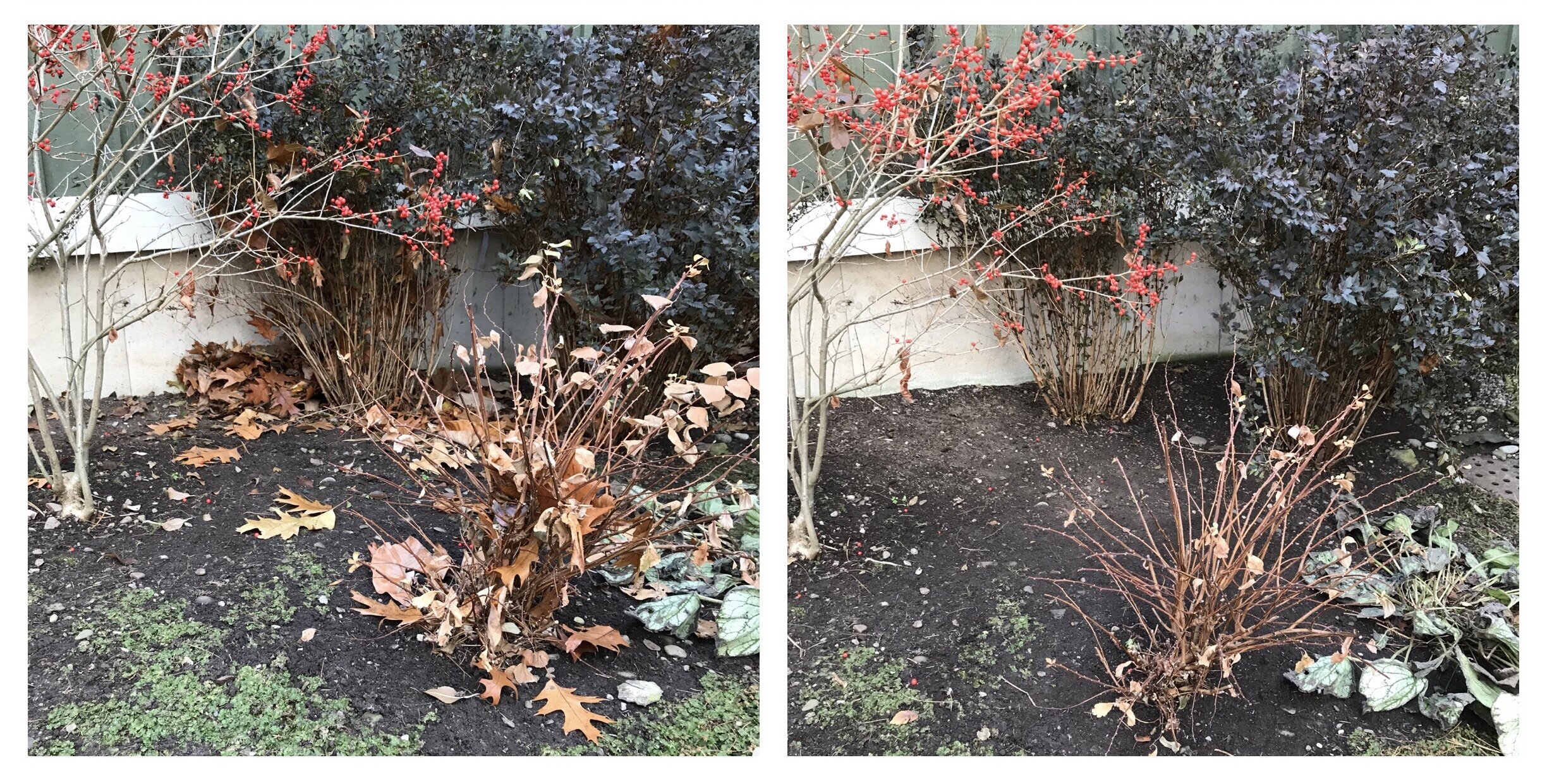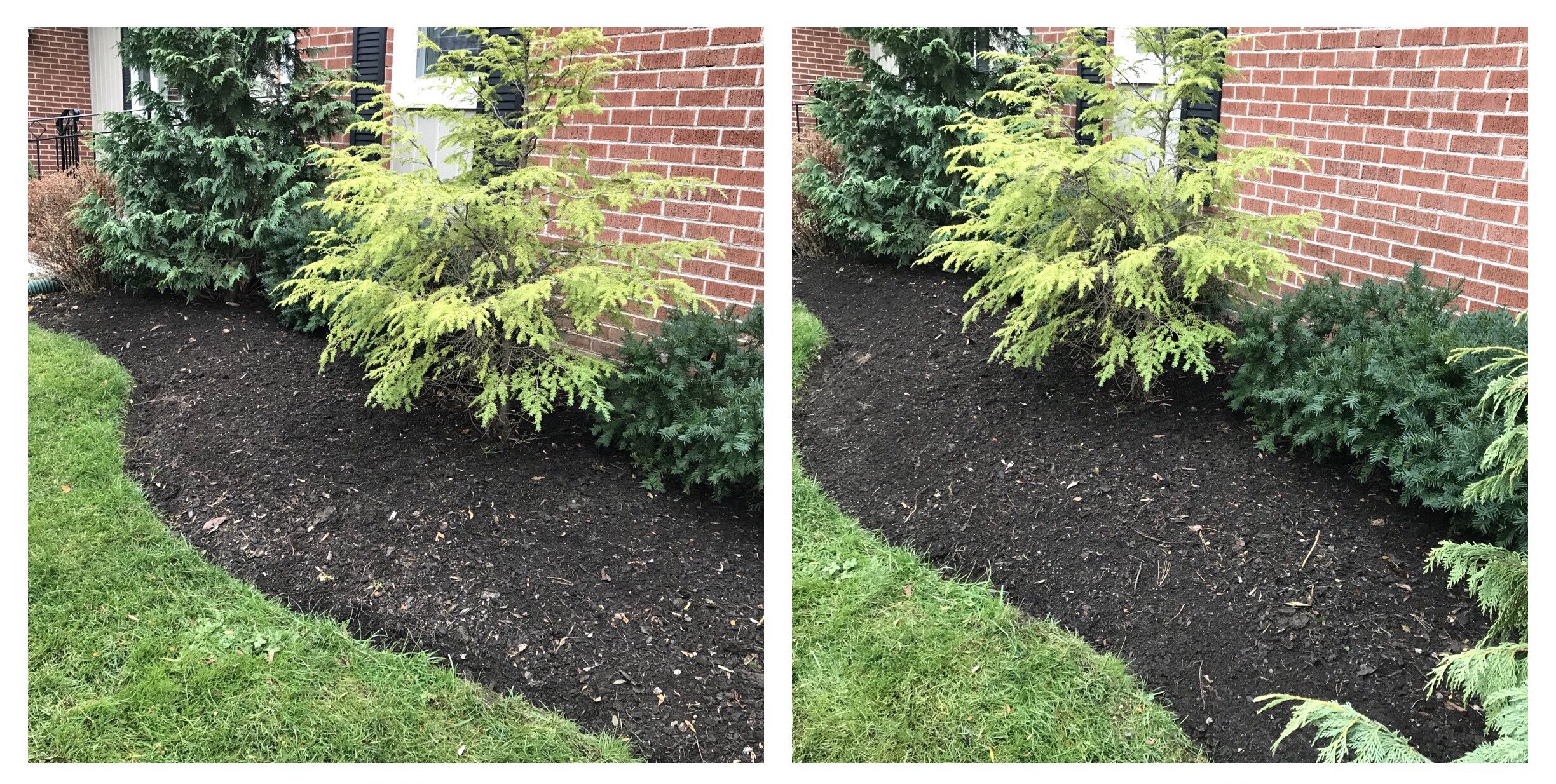Fall Clean-ups: Detailing
With the majority of the leaves down, fall clean-up is becoming less about ‘just getting leaves to the curb’ (or the compost pile or the leaf mulcher) and more about making the garden look tidy heading into the winter. Whether you prefer to strip your beds of leaves (with the plan to add lots of compost next year) or keep the leaves in place over the winter so that they can break down and add nutrients and organic matter to the soil, there are a few key tips that can ‘up the tidy factor’ in your fall garden (and protect your plants in the process).
Free your Plants!
When leaves from large trees fall, they cover the garden. (Thanks ‘Captain Obvious’!) During fall clean-up, these leaves are usually raked or blown out of the beds. What often gets neglected are all the leaves that have been captured by the branches of smaller trees and shrubs in the garden. Sure these plants look dead at this time of year, but they don’t have to look like debris traps! While it may seem tedious, picking out the leaves that have been trapped within the branches of your specimen trees/shrubs or even perennials, will greatly improve the overall tidiness of your garden.
A Spiraea betulifolia (birch leaf spirea) that has been effective at trapping leaves (left) and the same shrub with the oak leaves removed (right).
Leaves are left on this garden bed but they have been brushed off the clumps of [cut down] grass- this provides a little definition to the plantings and ‘ups the tidy factor’ despite the leaves remaining on the rest of the garden.
Picking out leaves becomes even more important when dealing with evergreen trees, shrubs, as well as groundcovers and other perennials. While leaves resting on the top of hedges or within the canopy of evergreens is really noticeable and unsightly, a build-up of fallen leaves can form thick mats on the evergreen needles/leaves which can smother/kill them. In the spring you can be left with a patchy-looking shrub or even a dead patch of groundcover. So, in the case of evergreens, it is not only aesthetically important to remove leaf litter (from on top of and within the plants), it is also important in maintaining plant health.
Leaves settled on top of a Taxus (yew) hedge (left) not only looks untidy but the leaves are not good for the yew foliage. Removing the leaves (right) is an easy fix.
A fair amount of leaf litter resting on top of Vinca minor (periwinkle) on the left and Pachysandra terminalis (Japanese spurge) on the right; leaves should not be allowed to pile up on evergreen groundcovers such as these.
Now that we have dealt with the top portion of our trees and shrubs, we will now shift our gaze and look beneath them. Leaf blowers are notorious for blowing leaves into the base of shrubs and firmly lodging them in place. Yes, the garden bed may look tidy and uniform (with the mulch and top soil completely stripped away… ‘leaf blower rant’ to follow in a future post!) but the shrubs look like they are being swallowed by leaves! Enter another tedious task with big a payback… picking out leaves from the base of your plants. This task is guaranteed to restore some definition to your plantings but it also serves another purpose. A pile-up of leaves at the base of plants can act like a really cozy and inviting home for rodents over the winter months; rodents that can nibble on and therefore damage your plants. In an effort to not lay out the red carpet for rodents, I try to keep the base of my trees, shrubs, and even perennial clumps free of leaf build-up.
Leaves caught up in branches and around the base of some shrubs (left) and the same shrubs with leaves removed.
A Taxus x media (yew) hedge showing one section with leaves caught in branches and beneath the plants, and another section where the leaves have been ‘picked out’.
Edge
With less plant material in the garden now, the edges of our garden beds become much more prominent- which means bad edges tend to stand out like a sore thumb! A quick pass with the garden edger can ‘crisp-up’ the lines again, and give the garden a tidier look. I will also rake the turf following along the edge of a garden bed to remove any mulch that has decided to take heed of the notion that ‘the grass is greener on the other side’. To further enhance the edge of beds (ones with a surface of bare soil or fine mulch), I will take a rake and do a light pass along the front of the garden bed to give it a nice uniform look. In general, regardless of the amount of debris you leave on the garden bed, if you can keep the edge of the bed tidy, you will improve the overall appearance of the garden.
Leaves tend to collect in the edges of garden beds. Even if leaves are left in the bed, scooping out the ones along the edge is a good ‘garden hack’ to help restore the lines of the garden and keep things looking tidy.
Fluff the Mulch
If you like cleaning leaves out your beds and you happen to have a layer of mulch on your gardens, now is the perfect time to turn or ‘fluff up’ the mulch- one final refresher before the snow flies!
And there you have it! These tips may seem minor and of low priority given the fact that the gardening season is coming to a close, but if you live in an area that does not receive reliable snowfall, then chances are you could be looking at your garden ‘as is’ for a fairly long time! These are all tasks that are often overlooked during fall clean-ups (by homeowners and professionals alike!) and I find that to complete a fall clean-up that really stands out… the tidiness is in the details.


![Leaves are left on this garden bed but they have been brushed off the clumps of [cut down] grass- this provides a little definition to the plantings and ‘ups the tidy factor’ despite the leaves remaining on the rest of the garden.](https://images.squarespace-cdn.com/content/v1/5cac2d06ab1a6213fa33fb3e/1575037003247-PX7P9JUOAJBJLBSSTGXW/IMG_0524.jpeg)





